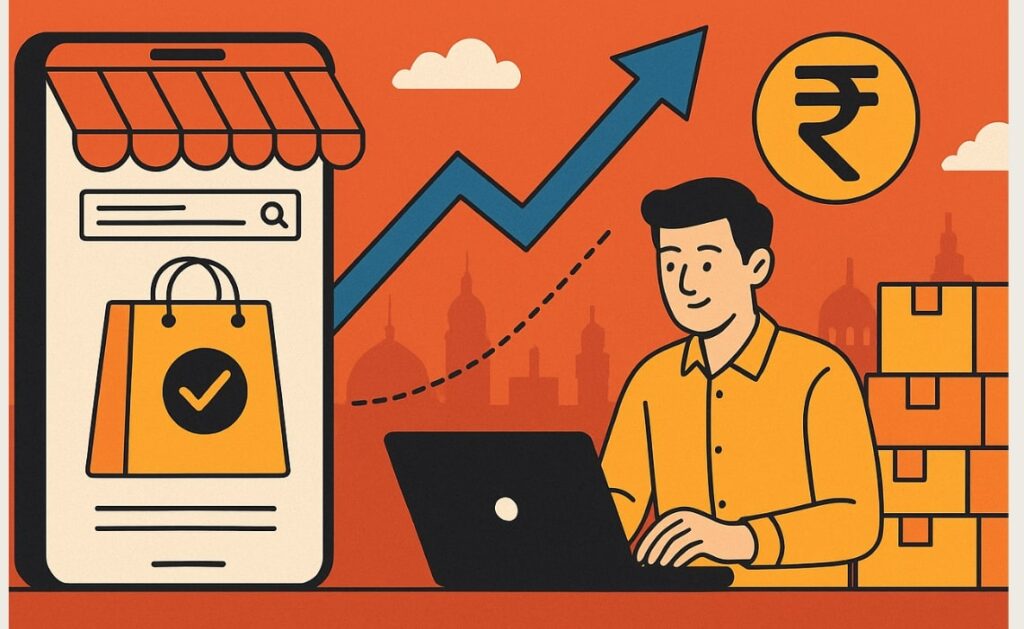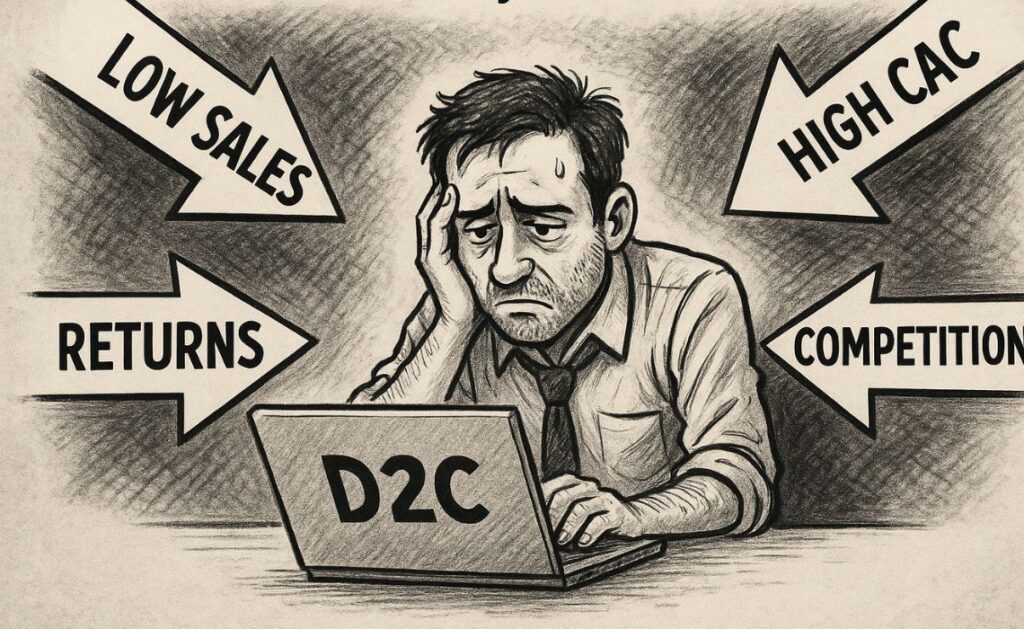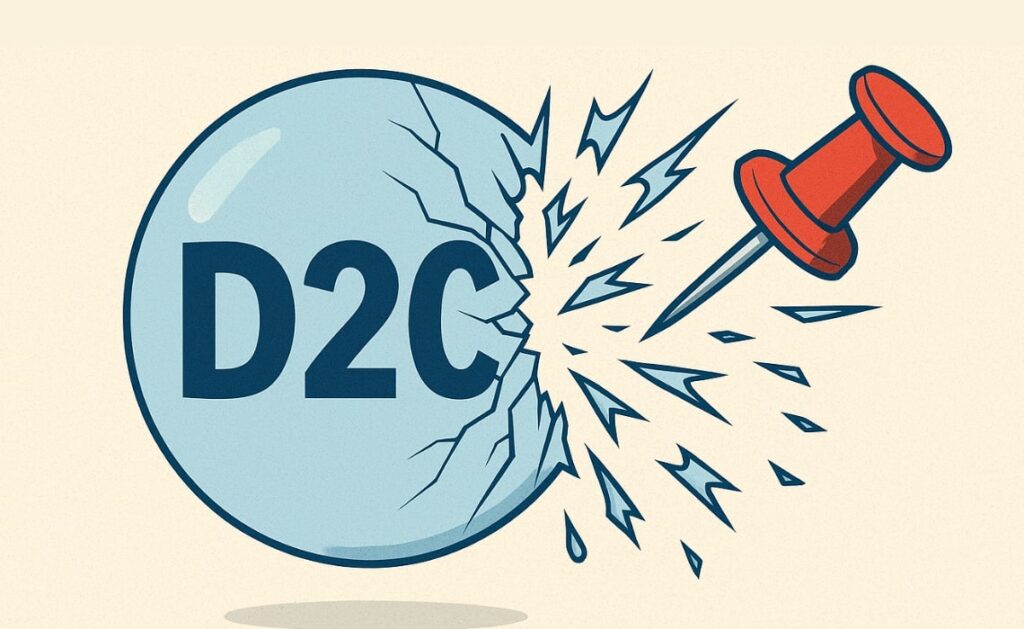Table Of Content
- How D2C Became India’s Startup Obsession
- The Harsh Reality No One Wants to Admit
- 1. Customer Acquisition Costs Are Crushing Margins
- 2. Brand Loyalty Is Shakier Than People Think
- 3. Logistics and Returns Eat Up Cash
- 4. Marketplace Dominance Is Unshakable
- 5. VC Funding Is Drying Up
- The Bubble Is Bursting — And It’s Visible Everywhere
- How Indian D2C Brands Can Survive — And Win
- 1. Ruthlessly Track Profitability
- 2. Build a Real Community — Not Just Discounts
- 3. Partner with Marketplaces Wisely
- 4. Innovate on Products, Not Just Ads
- 5. Embrace Regional and Vernacular Content
- My Final Word
- FAQs: The D2C Bubble Burst in India
A few years ago, I stood on a stage at a startup conference, listening to founders talk about D2C as the “future of Indian e-commerce.”
Everywhere I looked, new brands were launching with flashy websites, Instagram ads, and celebrity influencers. Investors were pouring money in. Founders were talking about “community building,” “brand love,” and “cutting out the middleman.”
It felt like we were living through a revolution.
And yet, as I write this in 2025, I can’t help feeling that much of this D2C revolution in India is crashing down.
Over the past year, I’ve spoken with dozens of founders, marketers, and investors. I’ve mentored young entrepreneurs struggling to keep the lights on. I’ve watched brands I admired quietly shut down, or pivot to marketplaces after burning through crores in digital ads.
So let me say this bluntly:
The D2C bubble in India is bursting. And many brands won’t survive past this year.
This isn’t just a market correction. It’s a hard lesson in how tough it is to build sustainable businesses in India.
And as someone who has run an e-commerce business for over a decade, I feel compelled to share what’s really going wrong — and how founders can avoid becoming casualties of this burst.
How D2C Became India’s Startup Obsession

Let’s rewind to the early 2010s.
Back then, selling online meant either joining marketplaces like Amazon and Flipkart or navigating an expensive, fragmented logistics ecosystem. Selling directly was a nightmare.
But between 2016 and 2021, things changed dramatically:
- Smartphone penetration exploded.
- Cheap mobile data (thanks, Jio) connected Tier 2 and Tier 3 India.
- Digital payments became mainstream, led by UPI.
- Platforms like Shopify, WooCommerce, and payment gateways made it easier than ever to launch your own online store.
Suddenly, launching a brand felt easy. You could:
- Find a manufacturer on B2B platforms like IndiaMART
- Launch a Shopify store in a week
- Run Facebook and Instagram ads
- Ship anywhere in India through aggregators like Shiprocket
And best of all: you “owned the customer relationship.”
It sounded perfect. And to some extent, it was. I admired the founders who built real businesses on top of these new tools.
But here’s the part nobody talks about:
Running a D2C brand in India is brutally expensive, complicated, and emotionally exhausting.
The Harsh Reality No One Wants to Admit

Over the past five years, I’ve seen D2C founders making the same painful discoveries I made while running my own e-commerce venture, Classystreet:
1. Customer Acquisition Costs Are Crushing Margins
I’ve personally run Facebook campaigns for my business. A few years ago, I could acquire a customer for ₹150-200. Today, the same customer might cost ₹400-600 — or more in competitive niches like beauty, fashion, or wellness.
Why?
- Privacy changes (Apple’s iOS updates) destroyed precise targeting.
- Ad competition exploded as every new D2C brand poured money into Meta and Google.
- Consumer fatigue set in. Everyone’s selling “clean beauty,” “premium teas,” or “sustainable fashion.”
Most D2C founders I talk to still haven’t cracked the code for sustainable CAC. They’re stuck in an endless cycle:
Spend money → acquire customer → hope for repeat purchase → spend more money because repeat rates are low.
2. Brand Loyalty Is Shakier Than People Think
A lot of founders believe D2C means “community.” They talk about their “tribe.”
Let me share a hard truth:
Most Indian consumers chase value.
Yes, they love great packaging and a brand story. But give them a bigger discount, and they’ll switch brands in a heartbeat.
I once surveyed Classystreet customers who’d purchased expensive handloom sarees. More than 65% said they’d bought from other websites too, mainly because:
- A better discount popped up.
- A festival sale offered free gifts.
- Another brand advertised faster shipping.
This is why so many D2C brands discover that lifetime value (LTV) is far lower than projections.
3. Logistics and Returns Eat Up Cash
D2C sounds amazing — until you deal with:
- Last-mile delivery costs
- High returns (especially in fashion and footwear)
- Inventory storage fees
- Reverse logistics nightmares
Quick-commerce has worsened consumer expectations. Platforms like Zepto and Blinkit promise delivery in minutes. Small D2C brands simply can’t match that speed affordably.
I’ve lost sleep over delayed shipments, damaged products, and angry customer emails. These things crush morale — and cash flow.
4. Marketplace Dominance Is Unshakable
I’ve heard countless founders say:
“We don’t want to sell on Amazon. It’s a race to the bottom.”
That sounds good in theory.
But when I check traffic stats, marketplace traffic dwarfs most D2C websites. Why?
- People trust Amazon and Flipkart’s delivery promises.
- Cash on Delivery is easier on marketplaces.
- Search behavior starts on marketplaces — not Google.
Many D2C brands eventually crawl back to marketplaces simply to survive.
5. VC Funding Is Drying Up
Between 2017 and 2021, funding flowed like water. Every week, a D2C startup raised a few million dollars for “growth marketing.”
But investors are wiser now.
They want:
- Proof of profitability
- Lower burn rates
- Real LTV:CAC ratios
Many D2C brands that grew fast are now slashing budgets, laying off teams, and looking for buyers.
The Bubble Is Bursting — And It’s Visible Everywhere

Here’s what I’m seeing in my network:
- Smaller D2C brands quietly shutting down their websites and moving entirely to marketplaces.
- Founders selling personal assets to pay vendors.
- VC conversations stalling after due diligence exposes thin margins.
- Brand collaborations and influencer deals slowing down because the money simply isn’t there.
Is D2C dead? No. But the D2C gold rush is over. And the fallout will be harsh in 2025.
How Indian D2C Brands Can Survive — And Win
Despite the doom and gloom, I’m not writing this to discourage founders. I’m writing it because I believe D2C still has a future — for those who build wisely.
Here’s my advice, based on running my own e-commerce business and helping others navigate these storms.
1. Ruthlessly Track Profitability
Don’t fall in love with “vanity metrics” like GMV or Instagram followers. Know your real:
- CAC
- LTV
- Gross margins after returns
- Fulfillment costs
If the math doesn’t work, your business won’t survive.
2. Build a Real Community — Not Just Discounts
The only way to lower CAC is to create customers who genuinely love you. That requires:
- Telling authentic brand stories
- Delivering incredible customer service
- Providing unique value (not just price)
Example: Mamaearth didn’t just sell beauty products. They leaned into sustainability, planting trees for each order. Customers felt emotionally invested.
3. Partner with Marketplaces Wisely
Don’t shun marketplaces completely. Use them strategically for:
- Brand discovery
- Faster inventory movement
- Cash flow during lean periods
But ensure your brand remains visible and differentiated.
4. Innovate on Products, Not Just Ads
The D2C space is flooded with me-too products. If your only differentiation is packaging, you’re vulnerable.
Consider:
- Unique formulations (beauty/health)
- New flavors or SKUs (F&B)
- Collaborations with artisans (fashion/handicrafts)
Innovation is your moat.
5. Embrace Regional and Vernacular Content
A huge opportunity lies in Bharat — Tier 2, 3, and 4 India. Brands winning here:
- Speak local languages
- Understand regional preferences
- Create localized marketing
Check this out: The Power of Local Language Marketing in Indian Ecommerce
My Final Word
I’ll be honest — writing this hurts me a little.
Because I admire the hustle of India’s D2C founders. I know what it’s like to pour your savings, energy, and soul into a brand you believe in.
But we can’t pretend the bubble isn’t bursting.
If you’re a D2C founder today, you have two choices:
- Keep burning cash hoping the old tactics will work
- Or pivot toward sustainability, profitability, and true brand loyalty
For those willing to evolve, there’s still an incredible opportunity.
India’s consumers are vast, diverse, and eager for new experiences. But we must respect their realities — and build businesses that can stand the test of time.
So if you’re sitting there, staring at your Shopify dashboard, wondering whether your business has a future…
Keep going. But build smarter.
And remember:
In India, D2C isn’t dead. But the hype is. Only the builders will remain standing.
— Debansh
FAQs: The D2C Bubble Burst in India
Q1. Is the D2C model dead in India?
No. But unsustainable D2C brands that rely purely on paid ads and discounting are struggling. The future belongs to profitable, innovative brands.
Q2. Should new founders avoid starting D2C brands?
Not necessarily. D2C still works in niche categories and with innovative products. Just be realistic about costs and competition.
Q3. Are marketplaces better than running your own site?
Marketplaces offer reach and trust. But margins are lower. Smart brands use both channels strategically.
Q4. What are India’s biggest D2C challenges in 2025?
High customer acquisition costs, intense competition, logistics costs, and reduced VC funding.
Q5. What’s one piece of advice for D2C founders?
Know your numbers. Profitability and customer loyalty are non-negotiable for survival.




